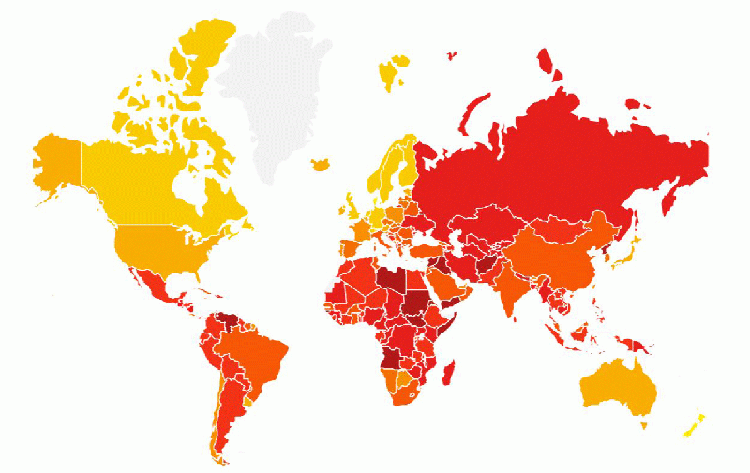Could Corruption-Beating Technology Bring on the Mark of the Beast?
Last week, the Columbia Broadcasting Network aired the first episode of its new reality show Hunted. It is billed as the most elaborate hide-and-seek game. Nine teams of two fugitives attempt to hide for 28 days somewhere within a 100,000-square-mile region from an elite team of 18 intelligence and operations experts. Any fugitive team that escapes capture after 28 days will be awarded a cash prize of $250,000.
If the show had aired thirty years ago, nearly every fugitive team would collect the cash prize. However, in our digital age of GPS satellites, social media, ubiquitous security cameras, smartphones, cell phone towers, surveillance satellites, and credit and debit cards, it is almost impossible to hide from technologically equipped authorities. The only chance the fugitive teams have is in their numbers and the limited amount of untraceable cash they are allowed to use. Capturing three or four fugitive teams for the hunters will be easy. Capturing all nine in just 28 days, even with technology, will be challenging.
While modern technology is stripping away much of our privacy, it is also proving to be a powerful tool for reining in corruption. One proof of that is a recent corruption map of the world published by the Transparency International organization (see figure below).
Figure: World Corruption Map—the most corrupt countries are dark red and the least corrupt are yellow. Credit: Transparency International
The map shows an inverse correlation between a nation’s level of accounting and surveillance technology and its level of corruption.
Another evidence of the capacity of modern technology to rein in corruption is a recently published report of an antipoverty experiment performed in Andhra Pradesh, India.1 In Andhra Pradesh, 19 million poor people are intended to benefit from a social safety net program where cash is transferred to them. The big problem is that most of the poor there do not have bank accounts. Thus, local officials or postal service employees distribute the cash to them directly. Typically, many different officials and employees handle the cash during the distribution process, resulting in thievery that substantially reduces the amounts the intended beneficiaries receive.
Countries like Indonesia have attempted to solve this corruption problem by distributing goods instead of cash. The Indonesian government makes available very low quality rice, rice that richer people would never eat, to its poor. Nevertheless, only about a third of the distributed rice actually gets in the hands of the poor.
There is another problem with the distribution of goods instead of cash. Instead of the poor buying what they really need, they must subsist on what the government thinks they need.
In two different social service programs, a workfare program that offers guaranteed employment for millions of poor households and a pension program that provides income for elderly poor people, smart cards replaced cash. The beneficiaries were given smart cards that were tied to their electronic fingerprints. Now, only the real beneficiaries could pick up the payments. The introduction of these smart cards reduced corruption by 41% in the workfare program and by 47% in the pension program. The poor in Andhra Pradesh still must use cash to make most of their purchases. Thus, while corruption is much reduced, it still persists.
A separate experiment in Niger revealed another economic benefit from modern accounting technology—mobile income transfers.2 Welfare program recipients who previously had to travel to a benefit distribution center and wait in line to receive their benefits instead were issued mobile devices. A study showed the time savings associated with the mobile transfers of funds resulted in the recipients taking better care of their households, and especially their dependents. The household diet diversity increased by 9–16% and the household children ate an additional one-third of a meal per day.
These technological advances in the distribution of funds may help answer a biblical prophecy question that I have been fielding ever since I taught a seven-year long Sunday school class on the book of Revelation in the 1970s. The question is what would ever cause virtually all the peoples of the world to receive the mark of the Beast that is mentioned in the thirteenth chapter of Revelation:
–Revelation 13:16–18
What is described in these three Bible verses is a totally cashless society. America already is a mostly cashless society. Most of our financial transactions are done with either credit and debit cards, smartphones, electronic funds transfers, or checks. These cash substitutes substantially reduce corruption and fraud and save us all a lot of time. However, these cash substitutes are not fraud-free. Someone can forge your check, phish your PIN at an ATM or phish your credit/debit card numbers at a gas station, or record your credit/debit card number and expiration date.
Yes, financial institutions have made enormous progress during the last five years in reducing the corruption and fraud. This corruption and fraud reduction, though, comes with price. Now we all must memorize dozens of passwords and PINs and every several months replace them with new ones. Financial institutions now have large staffs dedicated full-time to fraud and corruption reduction. I am certain, too, that I’m not alone in needing to field calls from my credit card companies about suspicious transactions, get my credit cards replaced, and subsequently have to call all the utility companies and charities for which I have arranged monthly payments to inform them of my new credit card information.
Wouldn’t it be a huge boost to the economic well-being of every human on the planet and a tremendous saving in time if we could get rid of cash and all the above-mentioned cash substitutes and replace them with an electronic chip surgically embedded under the skin of our forehead or our right hand? I remember back in 1975 calculating for my Sunday school class on Revelation the economic benefit of such a universal chip system. I determined that it would boost the gross domestic product of the world by at least 20%. Certain categories of crime would be completely eliminated. And we would all save a huge amount of time.
As for the 666, those of us with credit cards already carry on our persons the number 4444, four sets of four digit numbers. Three sets of six digit numbers would be adequate to appropriately identify every human being on Earth and his or her personal financial status.
As the book of Revelation warns, however, there are certain risks to such a totally cashless society. The authorities could be privy to every purchase and sale by every human being. They could use such a system to control the spending and selling behavior of us all. With an embedded chip in a human, the authorities could know the exact location and every movement of that human. They could know who that human came into contact with and at what time and place.
Revelation 13 predicts that a time will come when a financial system akin to what I have just described is instituted. It predicts that all the “coulds” in the preceding paragraph will become “woulds.” It predicts that the authorities will be controlled by just one authority, a single dictator who will demand the obedience and worship of every human being on Earth.
As bad as this prophecy sounds, Revelation speaks of a silver lining. The peoples of the world will suddenly recognize that they are in a spiritual battle that they cannot ignore. They will realize what they should have realized all along—that they have no choice but to choose between allegiance to Christ or allegiance to Satan. Revelation predicts that many who were spiritually resistant will come to their senses and choose Christ.
I first read the book of Revelation during my teenage years in the 1960s. Back then, I concluded that the technological advances required to make possible the fulfillment of its prophecies were so far off that there was no way any of Revelation’s end-times prophecies could occur during my lifetime. Today, I am not at all convinced that I will live long enough to see any Revelation prophecies beyond chapter three fulfilled. However, no longer do I see any technological barriers standing in the way of the fulfillment of all of Revelation’s prophecies.
For those of you who are curious about the course I taught on the book of Revelation, the entire course without any edits or updates (except for the elimination of class announcements and repetitive reviews) is now available as a set of four MP3s. You can access these MP3s at paradoxes.org/audio/audio.htm.
Allow me to conclude this article by repeating what I told my Sunday class more than 40 years ago. The book of Revelation is not just a prophecy about humanity’s future. It is primarily an exhortation to every human being who has ever lived—choose you this day whom you will serve: the Lord, Creator, and Savior Jesus Christ or Satan, the father of lies.
Endnotes
- Karthik Muralidharan, Paul Niehaus, and Sandip Sukhtankar, “Building State Capacity: Evidence from Biometric Smartcards in India,” American Economic Review 106 (October 2016): 2895–29, doi:10.1257/aer.20141346.
- Jenny C. Aker et al., “Payment Mechanisms and Antipoverty Programs: Evidence from a Mobile Money Cash Transfer Experiment in Niger,” Economic Development and Cultural Change 65 (October 2016): 1–37, doi:10.1086/687578.







